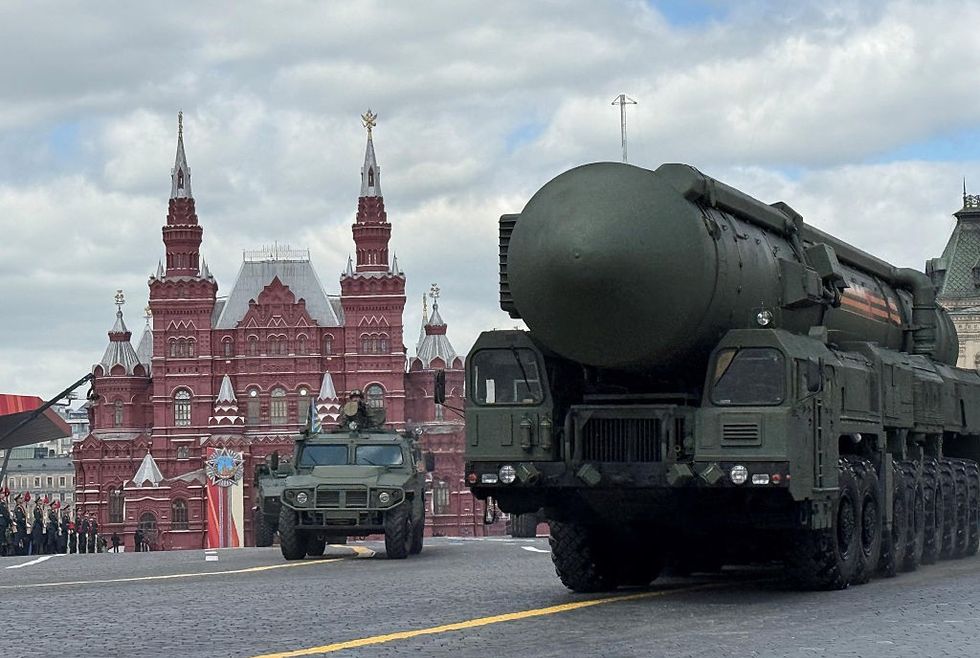
Beyond the rhetoric and policy, Russia has also taken more assertive actions with its nuclear forces – none more dramatic than the deployment of tactical non-strategic nuclear weapons to Belarus. Putin framed the move as a response to the West’s “aggressive policy” and similar to U.S. “nuclear sharing” arrangements with NATO allies.
Many experts say that Russia’s increased nuclear saber rattling is likely not a prelude to actual use of a nuclear weapon, but a tool Moscow is leveraging to influence and intimidate the West. Analysts also say Russia turns to the nuclear card when it seeks to offset or distract from conventional military setbacks in Ukraine.
“Those steps are part of a game to impress upon the West that the Russians are serious and that there are consequences of the West doing something,” Hans Kristensen, Director of the Nuclear Information Project at the Federation of American Scientists (FAS), told The Cipher Brief. “Or they need to demonstrate to the domestic audience that they’re tough, they’re not going to be pushed around.”
Kristensen is a co-author of the FAS’s Nuclear Notebook — a bi-monthly report which provides updates on the state of each of the nuclear weapons states’ arsenals. The latest iteration is about Russia. Kristensen spoke with The Cipher Brief about the report’s findings, Russia’s nuclear arsenal and doctrine, how the U.S. should be looking at its primary nuclear rival, and the role of nuclear weapons in geopolitics.
Kristensen spoke with Cipher Brief Editor/Writer Ethan Masucol. Their conversation has been edited for length and clarity.
The Cipher Brief: Could you tell us a bit about what the report found about the size of Russia’s nuclear arsenal today? And can you give some context to how that has looked in recent years?
Kristensen: We estimate that the Russians have something in the order of 4,300 nuclear warheads in their military stockpile. That is the inventory of weapons that is available for the military for use. But they also have a large number of warheads that have been retired and have not yet been dismantled. They’re in storage on their way to dismantlement. So that’s another 1,500 or so.
Their stockpile of 4,300, that is the largest in the world. The one that comes next is the U.S. We estimate the U.S. has about 3,700 warheads in the stockpile. Of the other nine nuclear weapons states, most just have a few hundred nuclear weapons.
China is now increasing [its arsenal], and has apparently passed 600 nuclear warheads. But that’s a work in progress. They’re not done, [and] they’re expected to continue to increase over the next decade or so. So we’ll see where they end up. They’re not talking about it. They’re not interested in having that conversation.
The Russians are much more established. They have a nuclear posture that very much mimics that of the United States, or the other way around. That’s simply because the two countries were the primary players in the nuclear competition during the Cold War, and so they are somewhat shaped the same. They have a triad of strategic forces, long-range land-based ballistic missiles, long-range submarine ballistic missiles, and strategic bombers that can fly at intercontinental range.
And then they have a large inventory of non-strategic or shorter-range nuclear forces. There’s a lot of interest in that category these days, but it’s not something new for the Russians, nor is it increasing particularly rapidly. But it’s something they have because many of their potential targets for nuclear weapons are in the periphery around Russia’s border. So they don’t obviously need intercontinental range weapons to deal with that.
The Russians are now in the middle – the second half, you could say, of a large-scale nuclear modernization of their forces that essentially is a replacement of Soviet-era nuclear weapon systems with modern systems.
The Cipher Brief: The report goes into this modernization drive. It seems that they’re doing better in some areas than others. Is that correct?
Kristensen: That’s correct. The emphasis so far has been in the upgrade of the land-based missile force. They’re doing work on all the legs, all the elements of it, but there they have made the most progress. They have finished upgrading all the road-mobile ICBMs from the Soviet air types. They’re working on the silo ones, still not done.
On the submarine force, they are a bit over halfway done with their modernization, which essentially consists of replacing Soviet-era Delta-class missile submarines with the new modern Borei-class that they have.
And on the bombers, they’re not doing a whole lot new. They’re upgrading the existing bombers they have. They will add better weapon systems, and they’re modernizing them in terms of new engines and avionics suites. They haven’t really gotten to the next-generation bomber yet.
And then on the shorter-range systems, [they’ve] modernized the whole inventory – land-based ballistic missiles, land-based cruise missiles, shorter-range jets with bombs, intermediate-range bombers with air-to-surface cruise missiles. And then the fleet, the Navy has a large inventory of weapons with anti-ship cruise missiles, land attack cruise missiles, anti-submarine weapons.
They also have defensive nuclear forces for their air defense systems, as well as for their anti-ballistic missile defense system – so far deployed around Moscow, but it’ll probably spread in the next decade or two.
The Cipher Brief: Your rundown is a reminder of how much more of an established player Russia is in this, compared to China, which you’ve described as a work in progress.
Kristensen: Yes, that’s very much true. This is a nuclear relationship that goes way back. They started developing their nuclear forces back in the late 1940s. And at some point during the Cold War, their arsenal was in the order of 30-40,000 nuclear warheads. That was insane.
Since then, it’s dropped tremendously to what we have now. And part of that is because the Cold War ended and a lot of these missions fell away or they didn’t need that much. And there was a window in the ‘90s where it was possible to change the relationship for the better between the United States and Russia, or the West and Russia. And as we know, that has now soured and we’re back in a strategic nuclear competition with Russia.
Experts are gathering at The Cipher Brief’s NatSecEDGE conference June 5-6 in Austin, TX to talk about the future of war. Be a part of the conversation.
The Cipher Brief: Russian nuclear doctrine and policy is changing now that we’re in this renewed era of competition. There was the change last year, lowering the threshold for nuclear use. Can you talk a bit about those recent developments?
Kristensen: The Russian nuclear strategy – they’re thinking about how they would potentially use nuclear weapons. It has evolved over the last decade. The point being that because of the way they have been behaving in the context of the Ukraine war, they have from day one tried to get the attention of the West to not get involved. And from very early on, they referred – sometimes indirectly, sometimes very directly – to nuclear forces, in their warnings to the West to stay out.
The West has largely followed that in terms of not getting directly involved in the war. But the Russians also wanted the West to not deliver long-range advanced weapons that could help the Ukrainians attack inside Russia. That did not work. The West supplied those weapons after all, regardless of Russian threats. We saw the Russians got really excited about that and tried to change the public nuclear doctrine in such a way that it communicated that they looked at this very seriously, and would consider using nuclear weapons if someone attacked Russia with weapons, even conventional weapons that had been supplied from outside. They’re really trying to sort of turn up the heat there on the rhetoric. They also broadened a range of scenarios beyond what had been described before. And so people very much interpreted that as a lowering of the threshold.
This could partially be part of the Russian public relations play, simply trying to impress upon the West that they’re really serious about this. They may also have a domestic audience in Russia, of course.
One thing that’s really difficult to figure out is to what extent has this doctrine change influenced the way the Russian military would actually use nuclear weapons? Does it influence the plans they already have? Does it influence when the president would say to do it? Do they need a doctrine document to be able to do whatever they need to do anyway? It’s very hard to see through this kind of fog of rhetoric, documents, posturing and these types of things, and get to what is the real nuts and bolts here in terms of how they would actually use nuclear weapons.
They have a large inventory. They would most likely—I don’t see why not—use nuclear weapons if they deemed it necessary for whatever purpose. I don’t think they need a doctrine document that looks in a certain way to do that. It’s a symbol of the dynamic nuclear competition we are in right now with the Russians that this kind of language, these kinds of documents and even training operations are being used to signal nuclear intentions.
The Cipher Brief: Rhetoric and language are one thing, but how do you react to things such as their deployment of tactical nuclear weapons to Belarus, their withdrawal from arms control treaties, and increase in testing? Are those actions indicative of a more serious change?
Kristensen: No, I don’t think so. Those steps are part of a game to impress upon the West that the Russians are serious and that there are consequences of the West doing something. Or they need to demonstrate to the domestic audience that they’re tough, and they’re not going to be pushed around.
The deployment to Belarus is important in the sense that the Soviet Union used to have nuclear weapons in Belarus and many other countries, but they were all pulled back into Russia. So now President Putin and [Alexander] Lukashenko, the Belarusian president, have come up with this arrangement by which the Russians supply [Belarus with] nuclear-capable forces—ballistic missile launchers, cruise missile launchers, ground launch systems, as well as equipping a small number of aircraft with the capabilities to drop nuclear bombs. They’ve gone out on several occasions and promoted that, having meetings and saying we’re doing things. So far, we see these forces participating occasionally in Russian nuclear exercises.
The Russians see them as sort of an extension of their tactical nuclear forces, if you will. The nuclear weapons for them are Russia’s. They’re not handing nuclear weapons over to Belarus. They’re building a nuclear storage site inside Belarus that appears to be intended to receive these nuclear warheads for those launchers if it’s necessary.
Putin and Belarus are going around saying, well, we’re just doing what NATO is doing in Europe. It’s a big nuclear power supplying nuclear weapons to its allies and nuclear sharing, and that is simply because we want to strengthen deterrence and protect our allies—this kind of language. But militarily, it doesn’t change that much because of course, it’s not like there’s anything that these weapons in Belarus can hit that Russia’s nuclear forces already cannot hit. So it doesn’t change the strategic landscape.
But it’s an important factor and it certainly is unnerving to the Poles and the Baltic states. They see it as another [example of] Russian nuclear saber rattling. So that’s going on and that’s really the only fundamentally new thing you could say in terms of the Russian non-strategic nuclear posture.
There is, of course, a public concern about this. People are nervous about what’s happening. But I don’t think people should be nervous about it in the sense that the Russians suddenly wake up one day and start using nuclear weapons. You would have to go through a number of steps before it would get to that. And it would have to involve, as far as I can see, a serious large-scale conventional war between Russia and NATO before we get to any level where it would be reasonable to assume that nuclear weapons could come into use.
Sign up for The Cipher Brief’s Nightcap newsletter: the best way to unwind every day while still staying up to speed on national security.Sign up today.
The Cipher Brief: How should the U.S. be looking at all this?
Kristensen: The way the U.S. has reacted to this has been twofold. One has been about the need to modernize nuclear forces in general. The United States has gotten to the point where some of its systems are getting old. It wants to replace them. There’s a big debate about how much it needs to do.
The other part has to do with whether they need to change their nuclear posture or operations in response to what the Russians have been doing. NATO and the United States have been reluctant so far to go into a tit-for-tat response. Whenever the Russians have been issuing nuclear threats, NATO has generally responded by saying, you’re not a responsible player. We don’t want to do these things. You shouldn’t rattle a sword. But in any case, we have the capabilities we need to have. We have the ability to respond and there’s nothing you can do about it.
I’ve been following the way that NATO and the United States have changed both the rhetoric, but also their operations of the nuclear forces. I would actually say that NATO has quietly changed the way it operates its nuclear forces more than Russia has. We see that in the shape of changes in where the bombers are operating over Europe. With Sweden and Finland having joined NATO, the northern area has become a very important operating area for strategic bombers.
With the ballistic missile submarines, normally they have been hiding in the ocean, not showing themselves very much at all. Over the last eight to 10 years, we’ve seen real change in terms of showing the submarines more by coming into ports in Europe or in the Mediterranean region. We see them come in, and often that means once or twice a year—that’s all they need to be able to show the flag, so to speak.
Last year we saw a unique demonstration of that capability. A [U.S.] ballistic missile submarine surfaced off the coast of Norway and there was a nuclear command and control aircraft used to transmit launch codes to the submarines deployed to a base in Norway. This submarine surfaced, the aircraft came out, a couple of other ships and aircraft were there as well. They invited Norwegian Ministry of Defense and Navy officials to come out and board the submarine and show the Norwegian flag and so forth. That is the most overt, in your face, here we are with nuclear weapons, don’t you do something stupid thing that I think we’ve seen so far.
So that’s the irony here. The Russians are big on words, but I think the West has been bigger on action.
One last thing here is that the U.S. has just shipped a new upgraded nuclear bomb to Europe. It’s replacing some that were already there, so they’re not increasing the number of nukes in Europe. Now there’s a big push in Congress among conservatives and defense hawks to build and field deploy a new nuclear sea-launched cruise missile that would go on the attack submarines. The U.S. used to have such a weapon during the Cold War, and there are people who argue that the United States should now reintroduce such a weapon. And the theory, of course, is that if they do it, then the Russians will behave and the Allies will be less afraid and so forth. But I bet that will not happen.
Read more expert-driven national security insights, perspective and analysis in The Cipher Brief because National Security is Everyone’s Business.


